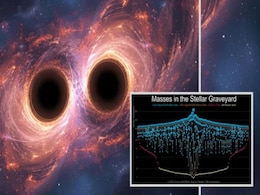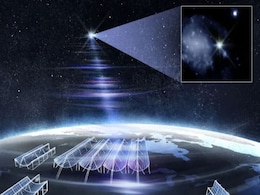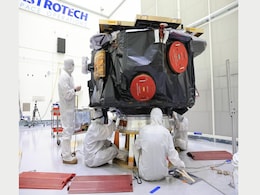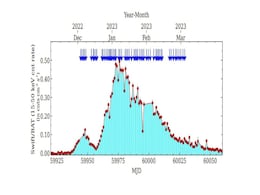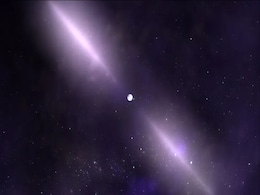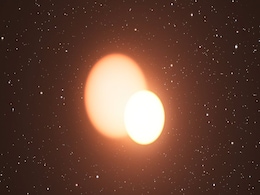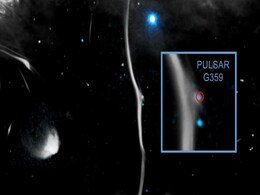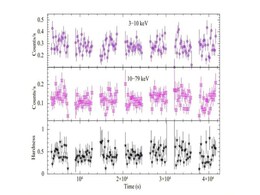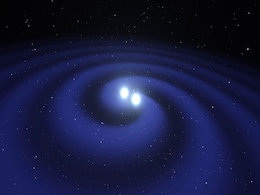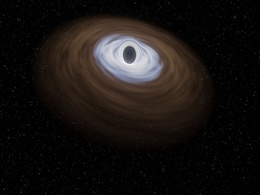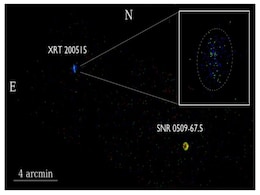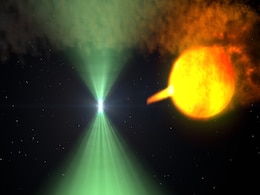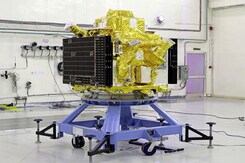Neutron Stars
- All
- News
- Videos
-

Astronomers Watch a Dormant Neutron Star Reignite After a Decade of Silence
- Monday December 15, 2025
Astronomers observed a neutron star known as P13 suddenly brighten after years of inactivity. The decade-long study shows how changes in accretion can drive extreme X-ray power, offering new insight into ultraluminous X-ray sources and neutron star physics.
-
 www.gadgets360.com
www.gadgets360.com
-

Astronomers Discover Stellar Graveyard Filled With Black Hole and Neutron Star Collisions
- Friday September 5, 2025
Astronomers using LIGO-Virgo-KAGRA detected 128 collisions of black holes and neutron stars, including two rare mixed mergers that double previous records. These findings reveal new details of stellar evolution, refine Hubble constant estimates, and test Einstein’s relativity in extreme conditions. The cosmic “graveyard” offers fresh insight ...
-
 www.gadgets360.com
www.gadgets360.com
-

Astronomers Detect RBFLOAT, Brightest Fast Radio Burst Ever Observed
- Monday August 25, 2025
An international team of astronomers has detected RBFLOAT, the brightest fast radio burst (FRB) ever recorded, just 130 million light-years away in Ursa Major. Detected by CHIME in March 2025, the powerful radio flash was traced to galaxy NGC-4141. Follow-up imaging with the James Webb Space Telescope revealed a faint stellar source near the burst,...
-
 www.gadgets360.com
www.gadgets360.com
-

Ursa Major III May Be a Star Cluster, Not a Dark-Matter Dwarf Galaxy
- Sunday August 24, 2025
Astronomers have long thought Ursa Major III, also called UNIONS 1, was a dark-matter-packed dwarf galaxy. But new simulations suggest it may instead be a compact star cluster bound by black holes and neutron stars. Located 30,000 light-years away, Ursa Major III contains just ~60 visible stars yet shows puzzlingly high stellar velocities. The new ...
-
 www.gadgets360.com
www.gadgets360.com
-

Chinese Astronomers Use Insight-HXMT to Decode X-ray Outburst of Binary Star System
- Tuesday August 5, 2025
In a recent study published on July 24 via arXiv, astronomers from Wuhan University have detailed the powerful X-ray outburst of the Be/X-ray binary system RX J0440.9+4431. Using China’s Insight-HXMT satellite, the team tracked the event from its eruption in December 2022 through March 2023.
-
 www.gadgets360.com
www.gadgets360.com
-

PSR J0922+0638 Pulsar Keeps Glitching Every 550 Days, Scientists Are Intrigued
- Thursday July 31, 2025
PSR J0922+0638, an ultradense neutron star, shows puzzling rotational glitches every 550 days. Using 22 years of radio data, scientists detected both abrupt and slow changes in its spin. These may be linked to magnetic field cycles or superfluid dynamics deep inside the star. However, the exact cause remains a mystery, demanding continued long-term...
-
 www.gadgets360.com
www.gadgets360.com
-

New Study Confirms TeV Halos Are Common in Middle-Aged Pulsars
- Thursday May 22, 2025
A recent study by researchers from the U.S. and Mexico using data from the HAWC Observatory has confirmed that TeV halos are a universal feature of middle-aged pulsars. These extended regions of gamma-ray emission are significantly larger than pulsar wind nebulae and may help identify otherwise undetectable pulsars. The findings challenge existing ...
-
 www.gadgets360.com
www.gadgets360.com
-

NASA Reveals a Fracture in Huge Cosmic Bone: Everything You Need to Know
- Monday May 12, 2025
With the use of the Chandra X-Ray Observatory, NASA has detected a fracture in the Milky Way. The bone is a galactic center filament that is based at a distance of 26,000 light years from Earth. The fracture would have occurred due to collisions with the neutron star, known as a pulsar, that spins rapidly. The scientists suspect that the fracture w...
-
 www.gadgets360.com
www.gadgets360.com
-

NASA Telescopes Reveal Hidden Properties of X-Ray Pulsar RX J0032.9-7348
- Monday May 12, 2025
A joint study using NASA’s NuSTAR and NICER telescopes has shed new light on RX J0032.9-7348, an X-ray pulsar in the Small Magellanic Cloud first identified 30 years ago. The pulsar exhibited a 7.02-second pulse period and underwent a significant X-ray brightening event in October 2024. Researchers noted a double-peaked pulse profile and measured...
-
 www.gadgets360.com
www.gadgets360.com
-

Magnetic Fields Could Significantly Influence Oscillations in Merging Neutron Stars, Study Finds
- Saturday April 26, 2025
Magnetic fields may play a bigger role in neutron star mergers than previously thought. A new study using advanced simulations shows that these fields can shift or suppress oscillation frequencies, altering gravitational wave signatures. This discovery could change how astronomers decode post-merger signals and refine models of neutron star interio...
-
 www.gadgets360.com
www.gadgets360.com
-

NASA Hubble Space Telescope Helps Confirm the First Solitary Black Hole
- Friday April 18, 2025
In the Sagittarius constellation, a lone and first-ever solitary black hole has been discovered by a team of scientists. Although the discovery began in the year 2011, the observations have confirmed it recently. The size of this black hole is as massive as seven times of the sun. Despite the conflicts and differences of observations by another tea...
-
 www.gadgets360.com
www.gadgets360.com
-

NASA’s Hubble Space Telescope Tracks a Neutron Star With Mysterious Origin
- Wednesday April 16, 2025
NASA’s Hubble Space Telescope spotted a rogue magnetar, dubbed SGR 0501+4516, traversing our galaxy for a significantly long time. As per claims by scientists, it was first discovered in the year 2008 by NASA's Swift Observatory as intense flashes of gamma rays in the outer area of the Milky Way
-
 www.gadgets360.com
www.gadgets360.com
-

Supernova Remnants Found in Oceanic Samples, Scientists Look to Moon
- Wednesday March 26, 2025
Scientists have identified supernova debris in deep-sea sediments, including a rare plutonium isotope linked to a kilonova. Researchers believe a neutron star collision occurred nearly 10 million years ago, scattering radioactive material across space. To validate this theory, they plan to analyze lunar soil, which remains undisturbed by Earth's ge...
-
 www.gadgets360.com
www.gadgets360.com
-

Unusual X-ray Flash in Large Magellanic Cloud Puzzles Astronomers
- Tuesday February 25, 2025
A brief yet intense X-ray flash, XRT 200515, was detected in NASA's Chandra telescope data from 2000. The signal, originating from the Large Magellanic Cloud, has left scientists debating its cause. Possible explanations include a neutron star pulling in gas from a companion star or a powerful flare from a distant magnetar. Researchers also specula...
-
 www.gadgets360.com
www.gadgets360.com
-

FAST Telescope Reveals Emission Properties of Three Long-Period Pulsars in New Study
- Monday February 17, 2025
The FAST telescope has observed emission behaviours in three long-period pulsars, revealing null phases, asymmetric pulses, and microstructures. The study highlights variations in pulsar emissions and their periodicity, contributing to a deeper understanding of neutron star radio emissions. Researchers noted different nulling fractions and microstr...
-
 www.gadgets360.com
www.gadgets360.com
-

Astronomers Watch a Dormant Neutron Star Reignite After a Decade of Silence
- Monday December 15, 2025
Astronomers observed a neutron star known as P13 suddenly brighten after years of inactivity. The decade-long study shows how changes in accretion can drive extreme X-ray power, offering new insight into ultraluminous X-ray sources and neutron star physics.
-
 www.gadgets360.com
www.gadgets360.com
-

Astronomers Discover Stellar Graveyard Filled With Black Hole and Neutron Star Collisions
- Friday September 5, 2025
Astronomers using LIGO-Virgo-KAGRA detected 128 collisions of black holes and neutron stars, including two rare mixed mergers that double previous records. These findings reveal new details of stellar evolution, refine Hubble constant estimates, and test Einstein’s relativity in extreme conditions. The cosmic “graveyard” offers fresh insight ...
-
 www.gadgets360.com
www.gadgets360.com
-

Astronomers Detect RBFLOAT, Brightest Fast Radio Burst Ever Observed
- Monday August 25, 2025
An international team of astronomers has detected RBFLOAT, the brightest fast radio burst (FRB) ever recorded, just 130 million light-years away in Ursa Major. Detected by CHIME in March 2025, the powerful radio flash was traced to galaxy NGC-4141. Follow-up imaging with the James Webb Space Telescope revealed a faint stellar source near the burst,...
-
 www.gadgets360.com
www.gadgets360.com
-

Ursa Major III May Be a Star Cluster, Not a Dark-Matter Dwarf Galaxy
- Sunday August 24, 2025
Astronomers have long thought Ursa Major III, also called UNIONS 1, was a dark-matter-packed dwarf galaxy. But new simulations suggest it may instead be a compact star cluster bound by black holes and neutron stars. Located 30,000 light-years away, Ursa Major III contains just ~60 visible stars yet shows puzzlingly high stellar velocities. The new ...
-
 www.gadgets360.com
www.gadgets360.com
-

Chinese Astronomers Use Insight-HXMT to Decode X-ray Outburst of Binary Star System
- Tuesday August 5, 2025
In a recent study published on July 24 via arXiv, astronomers from Wuhan University have detailed the powerful X-ray outburst of the Be/X-ray binary system RX J0440.9+4431. Using China’s Insight-HXMT satellite, the team tracked the event from its eruption in December 2022 through March 2023.
-
 www.gadgets360.com
www.gadgets360.com
-

PSR J0922+0638 Pulsar Keeps Glitching Every 550 Days, Scientists Are Intrigued
- Thursday July 31, 2025
PSR J0922+0638, an ultradense neutron star, shows puzzling rotational glitches every 550 days. Using 22 years of radio data, scientists detected both abrupt and slow changes in its spin. These may be linked to magnetic field cycles or superfluid dynamics deep inside the star. However, the exact cause remains a mystery, demanding continued long-term...
-
 www.gadgets360.com
www.gadgets360.com
-

New Study Confirms TeV Halos Are Common in Middle-Aged Pulsars
- Thursday May 22, 2025
A recent study by researchers from the U.S. and Mexico using data from the HAWC Observatory has confirmed that TeV halos are a universal feature of middle-aged pulsars. These extended regions of gamma-ray emission are significantly larger than pulsar wind nebulae and may help identify otherwise undetectable pulsars. The findings challenge existing ...
-
 www.gadgets360.com
www.gadgets360.com
-

NASA Reveals a Fracture in Huge Cosmic Bone: Everything You Need to Know
- Monday May 12, 2025
With the use of the Chandra X-Ray Observatory, NASA has detected a fracture in the Milky Way. The bone is a galactic center filament that is based at a distance of 26,000 light years from Earth. The fracture would have occurred due to collisions with the neutron star, known as a pulsar, that spins rapidly. The scientists suspect that the fracture w...
-
 www.gadgets360.com
www.gadgets360.com
-

NASA Telescopes Reveal Hidden Properties of X-Ray Pulsar RX J0032.9-7348
- Monday May 12, 2025
A joint study using NASA’s NuSTAR and NICER telescopes has shed new light on RX J0032.9-7348, an X-ray pulsar in the Small Magellanic Cloud first identified 30 years ago. The pulsar exhibited a 7.02-second pulse period and underwent a significant X-ray brightening event in October 2024. Researchers noted a double-peaked pulse profile and measured...
-
 www.gadgets360.com
www.gadgets360.com
-

Magnetic Fields Could Significantly Influence Oscillations in Merging Neutron Stars, Study Finds
- Saturday April 26, 2025
Magnetic fields may play a bigger role in neutron star mergers than previously thought. A new study using advanced simulations shows that these fields can shift or suppress oscillation frequencies, altering gravitational wave signatures. This discovery could change how astronomers decode post-merger signals and refine models of neutron star interio...
-
 www.gadgets360.com
www.gadgets360.com
-

NASA Hubble Space Telescope Helps Confirm the First Solitary Black Hole
- Friday April 18, 2025
In the Sagittarius constellation, a lone and first-ever solitary black hole has been discovered by a team of scientists. Although the discovery began in the year 2011, the observations have confirmed it recently. The size of this black hole is as massive as seven times of the sun. Despite the conflicts and differences of observations by another tea...
-
 www.gadgets360.com
www.gadgets360.com
-

NASA’s Hubble Space Telescope Tracks a Neutron Star With Mysterious Origin
- Wednesday April 16, 2025
NASA’s Hubble Space Telescope spotted a rogue magnetar, dubbed SGR 0501+4516, traversing our galaxy for a significantly long time. As per claims by scientists, it was first discovered in the year 2008 by NASA's Swift Observatory as intense flashes of gamma rays in the outer area of the Milky Way
-
 www.gadgets360.com
www.gadgets360.com
-

Supernova Remnants Found in Oceanic Samples, Scientists Look to Moon
- Wednesday March 26, 2025
Scientists have identified supernova debris in deep-sea sediments, including a rare plutonium isotope linked to a kilonova. Researchers believe a neutron star collision occurred nearly 10 million years ago, scattering radioactive material across space. To validate this theory, they plan to analyze lunar soil, which remains undisturbed by Earth's ge...
-
 www.gadgets360.com
www.gadgets360.com
-

Unusual X-ray Flash in Large Magellanic Cloud Puzzles Astronomers
- Tuesday February 25, 2025
A brief yet intense X-ray flash, XRT 200515, was detected in NASA's Chandra telescope data from 2000. The signal, originating from the Large Magellanic Cloud, has left scientists debating its cause. Possible explanations include a neutron star pulling in gas from a companion star or a powerful flare from a distant magnetar. Researchers also specula...
-
 www.gadgets360.com
www.gadgets360.com
-

FAST Telescope Reveals Emission Properties of Three Long-Period Pulsars in New Study
- Monday February 17, 2025
The FAST telescope has observed emission behaviours in three long-period pulsars, revealing null phases, asymmetric pulses, and microstructures. The study highlights variations in pulsar emissions and their periodicity, contributing to a deeper understanding of neutron star radio emissions. Researchers noted different nulling fractions and microstr...
-
 www.gadgets360.com
www.gadgets360.com


